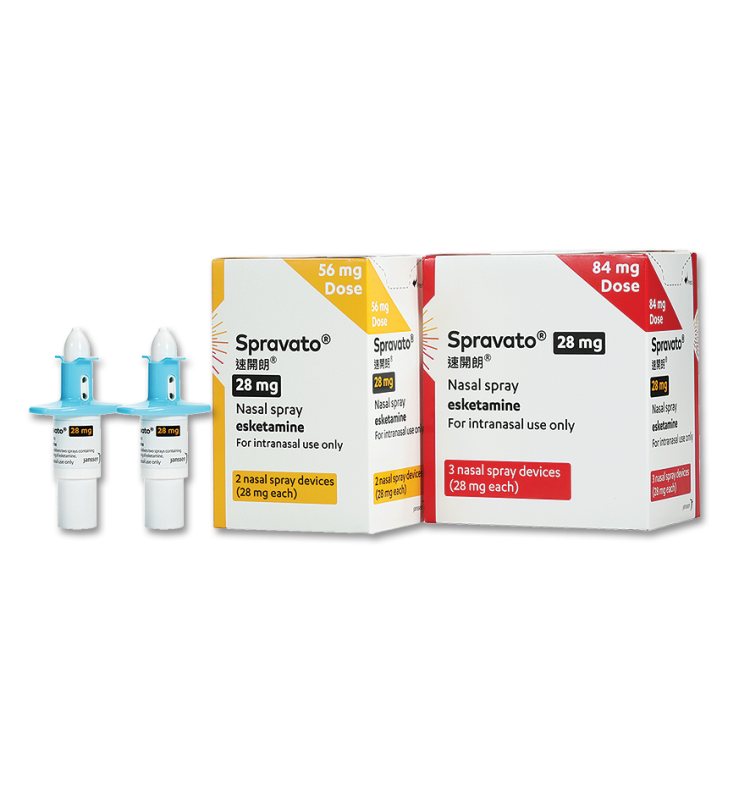The First New MoA Approved in 30 Years1-6 †
• SPRAVATO
®, in combination with a SSRI or SNRI, is indicated for adults with treatment-resistant Major Depressive Disorder, who have not responded to at least two different treatments with antidepressants in the current moderate to severe depressive episode
1
• Onset as early as 24 hours
6 *‡
• First glutamate-based MoA for Treatment-Resistant Depression treatment in adults
1-5 *†
• 70% reduced risk of relapse in patients who were stable responders at Week 16
7 §
*SPRAVATO
®, in combination with a SSRI or SNRI, is indicated for adults with treatment-resistant Major Depressive Disorder, who have not responded to at least two different treatments with antidepressants in the current moderate to severe depressive episode
1.
†Following the development and approval of the SSRI fluoxetine in 1987, approved treatments (including ‘atypical’ antidepressants such as mirtazapine, agomelatine etc.) have either focused on, or continued to have at least some effect on, the monoaminergic system
2–5.
‡The difference in least square mean in Montgomery-Åsberg Depression Rating Scale (MADRS) score between treatment groups at 24 hours after dosing was -3.3 (95% CI=25.75, 20.85), a clinically meaningful treatment result favoring SPRAVATO
®. The TRANSFORM-2 was a phase 3, double-blind, active-controlled, multicenter study involving 227 adults with moderate to severe depression and a history of nonresponse to at least two antidepressants in the current episode. Confirmed nonresponders were randomly assigned to treatment with SPRAVATO
® (56 or 84 mg twice weekly)+an antidepressant or an antidepressant+placebo nasal spray for 4 weeks. The primary efficacy endpoint was change in MADRS score from baseline to day 28
6.
§Compared with antidepressant and placebo treatments. The SUSTAIN-1 was a phase 3, multicenter, double-blind, randomized withdrawal study conducted at outpatient referral centers, enrolling 705 adults with confirmed treatment-resistant depression. In the 4-week induction phase, patients received esketamine nasal spray (56 or 84mg, flexibly dosed) twice weekly plus a new oral antidepressant (duloxetine, escitalopram, sertraline, or extended-release venlafaxine) administered daily. 455 participants entered the optimization phase which study drug dosages at the end of the induction phase remained fixed, with frequency of intranasal dosing reduced to once weekly for 4 weeks then individualized to weekly or every 2 weeks based on the severity of depressive symptoms. After 16 weeks of SPRAVATO
® treatment, participants achieving stable remission or stable response entered the randomized withdrawal maintenance phase with the same dosage as the induction phase. Nasal spray treatment was self-administered either once weekly or every 2 weeks. The primary efficacy endpoint was time to relapse in patients who achieved stable remission, as assessed using a weighted combination log-rank test
7.
References: 1. SPRAVATO® Hong Kong Prescribing Information P01.
2. Hillhouse TM, et al. Exp Clin Psychopharmacol. 2015;23:1-21.
3. Li YF. Pharmacol Ther. 2020;208:107494.
4. Whiting DW, Cowen DJ. Psychiatrist. 2013;37:356–358.
5. Harmer CJ, et al. Lancet Psychiatry. 2017;4: 409–418.
6. Popova V, et al. Am J Psychiatry. 2019;176:428-438.
7. Daly E, et al. JAMA Psychiatry. 2019;76:893-903.
CP-252842 Aug 2021
JANSSEN, A DIVISION OF JOHNSON & JOHNSON HK LTD
13/F, Tower 1, Grand Century Place, 193 Prince Edward Rd West, Mongkok
Tel: (+852) 2736 1711 • Fax: (+852) 2736 1926
